Do you have a question about the Bernina virtuosa 150 and is the answer not in the manual?
Reduce risk of electric shock by following safety rules for plugged-in machines and cleaning.
Reduce risk of burns, fire, shock, or injury by adhering to usage, maintenance, and child safety guidelines.
Guidelines for servicing machines with double insulation systems.
Identifies parts visible from the front and back of the machine.
Identifies parts on the left and right sides of the machine.
Storing and accessing the machine and its accessories.
Connecting power cable, foot control, and using the power switch.
Attaching the sewing table and using the FHS presser foot lifter.
Steps for winding and inserting the bobbin correctly.
Procedures for changing needles and presser feet.
Guide for threading the upper thread and bringing up the lower thread.
Adjusting thread tension, using thread cutter, and feed-dog settings.
Understanding the main switch, screen, and basic controls.
Selecting and modifying stitch width, length, and needle position.
Utilizing functions like mirror image, memory, and quick reverse.
Step-by-step guides for various manual and automatic buttonholes.
Understanding the memory screen, user buttons, and stored items.
Adjusting balance for stitch quality and presser foot pressure for fabric feed.
Replacing pre-programmed stitches with custom selections.
Detailed list and descriptions of stitches for the Virtuosa 150 QE.
Detailed list and descriptions of stitches for the Virtuosa 160 Plus.
In-depth descriptions of specific stitches for the Virtuosa 150 QE.
In-depth descriptions of specific stitches for the Virtuosa 160 Plus.
Overview of the standard presser feet provided with the machine.
Recommended optional feet for specific sewing tasks.
Importance of needle type, thread compatibility, and needle condition.
A table matching needle types to fabric and thread requirements.
How the feed-dog moves fabric and its importance for stitch formation.
Techniques for maintaining fabric grip when sewing corners.
Steps for cleaning the machine, hook, and screen.
Guidelines for lubrication and replacing the sewing light bulb.
Basic checks for common faults like threading and cleanliness.
Causes and solutions for thread breaks and skipped stitches.
Addressing slow running, reverse function, and needle breakage.
How to sew a straight stitch, adjust length, and position.
Using the securing stitch for reinforcing seams.
Overview of decorative stitches and how to adjust settings.
Merging decorative stitches with functions like mirror image.
Saving practical/decorative stitches, letters, and numbers in memory.
Selecting letter styles, correcting, and leaving memory.
Explaining open, closed, flat joining, and zig-zag seams.
Triple straight stitch, super stretch, vari-overlock, double overlock, stretch overlock, flat joining seams.
Creating visible hems on jersey fabrics.
Sewing strong visible hems on dense fabrics.
Using correct needles, thread, and presser foot pressure for knits.
Honeycomb stitch self-facing and ribbing with overlock seam.
Technique for finishing knit ribbing with an overlock seam.
Step-by-step guide for sewing zippers neatly.
Using the blind stitch foot for invisible hems.
Techniques for sewing narrow and shirring elastic with various stitches.
Using the running stitch for sewing wide elastic bands.
Tension, marking, testing, and balance for buttonholes.
Step-by-step guide for manual buttonholes.
Using automatic functions for standard buttonholes.
Detailed steps for sewing automatic keyhole buttonholes.
Creating buttonholes with stitch counting and automatic repetition.
Techniques for reinforcing buttonholes with gimp.
Methods for cutting buttonholes open and creating eyelets.
Achieving a hand-sewn look with specific stitch and foot.
Using the patchwork foot for precise seams and easier work.
Techniques for free-motion quilting and darning.
Finishing knit edges to prevent stretching with shirring elastic.
Quick methods for mending tears and worn areas using running stitch.
Reinforcing and attaching patches to woven materials.
Attaching patches to stretchy fabrics while maintaining elasticity.
Utilizing the machine's darning program with different feet.
Step-by-step guide for manual darning on various fabric types.
Reduce risk of electric shock by following safety rules for plugged-in machines and cleaning.
Reduce risk of burns, fire, shock, or injury by adhering to usage, maintenance, and child safety guidelines.
Guidelines for servicing machines with double insulation systems.
Identifies parts visible from the front and back of the machine.
Identifies parts on the left and right sides of the machine.
Storing and accessing the machine and its accessories.
Connecting power cable, foot control, and using the power switch.
Attaching the sewing table and using the FHS presser foot lifter.
Steps for winding and inserting the bobbin correctly.
Procedures for changing needles and presser feet.
Guide for threading the upper thread and bringing up the lower thread.
Adjusting thread tension, using thread cutter, and feed-dog settings.
Understanding the main switch, screen, and basic controls.
Selecting and modifying stitch width, length, and needle position.
Utilizing functions like mirror image, memory, and quick reverse.
Step-by-step guides for various manual and automatic buttonholes.
Understanding the memory screen, user buttons, and stored items.
Adjusting balance for stitch quality and presser foot pressure for fabric feed.
Replacing pre-programmed stitches with custom selections.
Detailed list and descriptions of stitches for the Virtuosa 150 QE.
Detailed list and descriptions of stitches for the Virtuosa 160 Plus.
In-depth descriptions of specific stitches for the Virtuosa 150 QE.
In-depth descriptions of specific stitches for the Virtuosa 160 Plus.
Overview of the standard presser feet provided with the machine.
Recommended optional feet for specific sewing tasks.
Importance of needle type, thread compatibility, and needle condition.
A table matching needle types to fabric and thread requirements.
How the feed-dog moves fabric and its importance for stitch formation.
Techniques for maintaining fabric grip when sewing corners.
Steps for cleaning the machine, hook, and screen.
Guidelines for lubrication and replacing the sewing light bulb.
Basic checks for common faults like threading and cleanliness.
Causes and solutions for thread breaks and skipped stitches.
Addressing slow running, reverse function, and needle breakage.
How to sew a straight stitch, adjust length, and position.
Using the securing stitch for reinforcing seams.
Overview of decorative stitches and how to adjust settings.
Merging decorative stitches with functions like mirror image.
Saving practical/decorative stitches, letters, and numbers in memory.
Selecting letter styles, correcting, and leaving memory.
Explaining open, closed, flat joining, and zig-zag seams.
Triple straight stitch, super stretch, vari-overlock, double overlock, stretch overlock, flat joining seams.
Creating visible hems on jersey fabrics.
Sewing strong visible hems on dense fabrics.
Using correct needles, thread, and presser foot pressure for knits.
Honeycomb stitch self-facing and ribbing with overlock seam.
Technique for finishing knit ribbing with an overlock seam.
Step-by-step guide for sewing zippers neatly.
Using the blind stitch foot for invisible hems.
Techniques for sewing narrow and shirring elastic with various stitches.
Using the running stitch for sewing wide elastic bands.
Tension, marking, testing, and balance for buttonholes.
Step-by-step guide for manual buttonholes.
Using automatic functions for standard buttonholes.
Detailed steps for sewing automatic keyhole buttonholes.
Creating buttonholes with stitch counting and automatic repetition.
Techniques for reinforcing buttonholes with gimp.
Methods for cutting buttonholes open and creating eyelets.
Achieving a hand-sewn look with specific stitch and foot.
Using the patchwork foot for precise seams and easier work.
Techniques for free-motion quilting and darning.
Finishing knit edges to prevent stretching with shirring elastic.
Quick methods for mending tears and worn areas using running stitch.
Reinforcing and attaching patches to woven materials.
Attaching patches to stretchy fabrics while maintaining elasticity.
Utilizing the machine's darning program with different feet.
Step-by-step guide for manual darning on various fabric types.
| Stitch Width | 5.5 mm |
|---|---|
| Sewing Speed | 900 stitches per minute |
| Free Arm | Yes |
| Display | LCD |
| Automatic Needle Threader | Yes |
| Drop Feed | Yes |
| Hook System | CB |
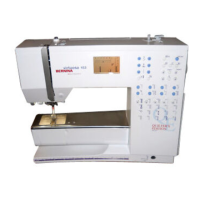
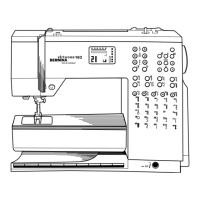



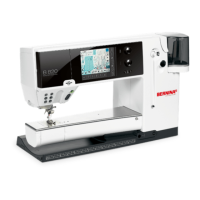
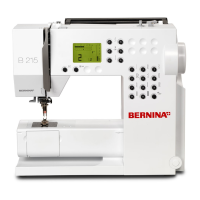

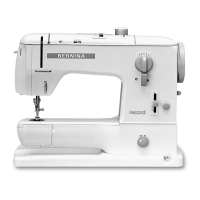
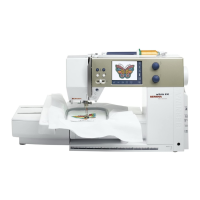
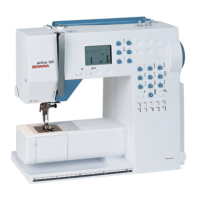

